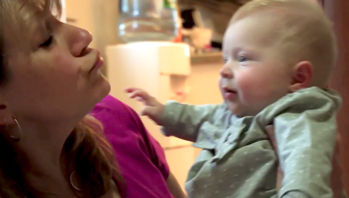Babble Talk

© Commonwealth of Massachusetts, Department of Early Education and Care. All rights reserved.
Babies love to babble talk. When they start to babble, make a game of talking with them in their babble “language.” Research shows that babies lip-read as they practice new sounds, so get close and let the baby watch your mouth. Try these ideas:
- Imitate a sound baby makes. Then pause to see if he will repeat it. If he does, imitate it again. Take turns as long as he shows interest.
- Give baby a toy animal and introduce animal sounds, such as moo, moo or baa, baa, as part of the play. Encourage him to repeat the sounds.
- Extend a baby’s babble phrase: If he says ba-ba, respond with ba-ba-BA.
- Introduce a new sound: If he says ba-ba, respond with da-da or ba-ba-DA.
- Teach older children to get close and engage a baby in babble talk.
Don’t forget to use real words, too! The more words a baby hears in face-to-face conversation and the more conversation turns he takes, the stronger his language will be in the toddler years and beyond.
- Play face-to-face conversation games using nursery rhymes, questions, chitchat, and affectionate comments.
- Notice when older babies begin to babble longer strings that sound like sentences. Respond to them with words you guess the babies are saying or with answers to what you think they mean.
At first, babies babble talk includes sounds from all languages. Over time, they limit their babbling to speech sounds of the languages they hear. So, if you introduce a babbling baby to a new language, he will learn its sounds easily and use them in his babble talk.
